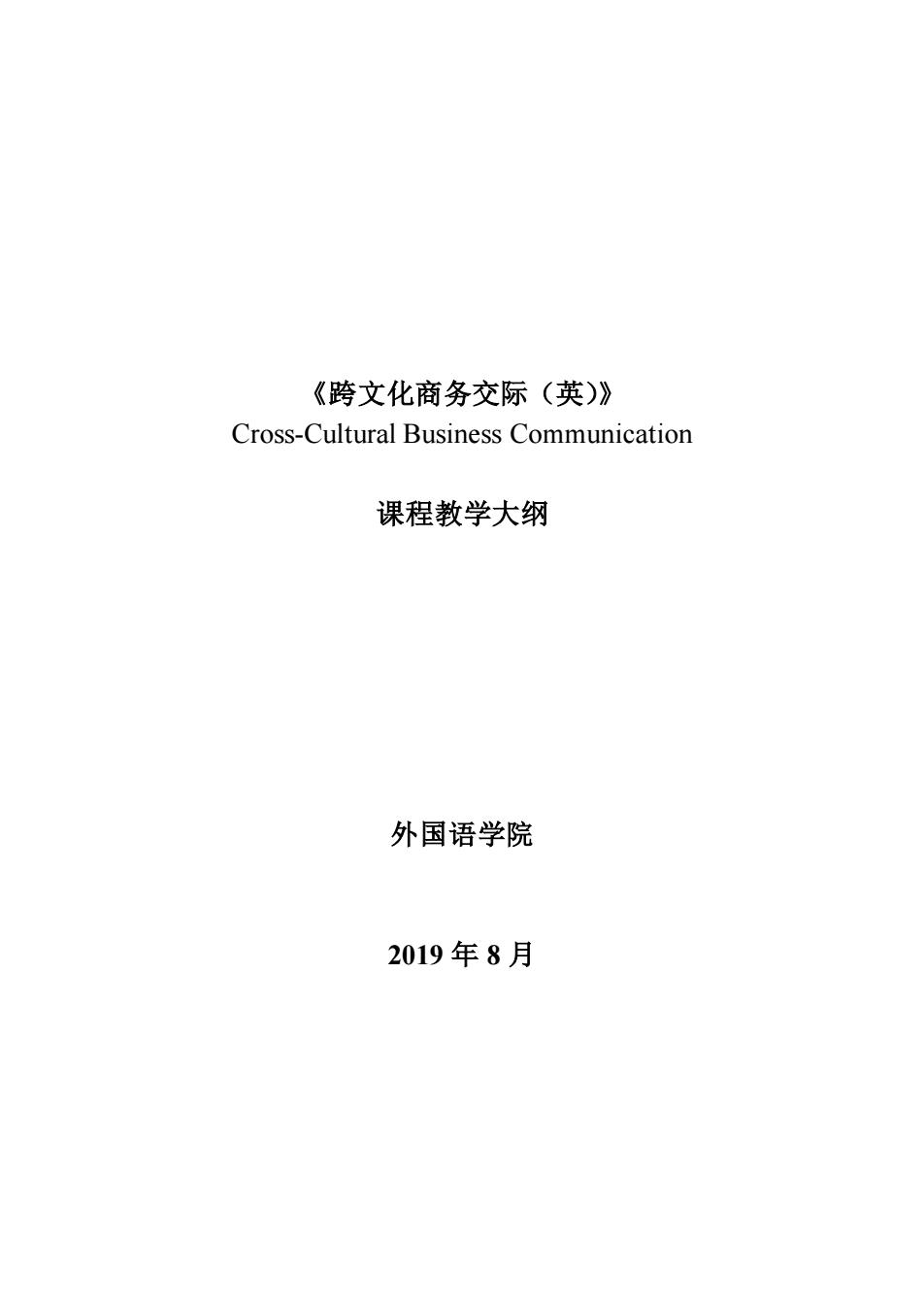
《跨文化商务交际(英)》 Cross-Cultural Business Communication 课程教学大纲 外国语学院 2019年8月
《跨文化商务交际(英)》 Cross-Cultural Business Communication 课程教学大纲 外国语学院 2019 年 8 月

《跨文化商务交际(英)》课程教学大纲 1.The basic information of the course Course Code:16074302 Course Name:Cross-Cultural Business Communication Course category:N/A Class hours:32 Credits:2 Applicable to:Sophomore-year students,Business English Assessment method:oral examination Prerequisites:None 2.The course introduction At present,China's economy is growing rapidly,cultural exchanges and tourism are booming.The number of foreign-owned and joint ventures in Guangdong has increased.and economic and cultural exchanges with international personnel have increased.Cross-Cultural Business Communication has become an important aspect of Greater Bay's local culture.As a major national regional strategy,the Guangdong-Hong Kong-Macao Greater Bay Area has a strong domestic demand market and national policy support,where global technology,capital and talents are rapidly gathering,and various industries under the new economic format have taken on a new form.However,some people have cultural misunderstandings or feel unconfident,which reduces the benefits of cross-cultural business communication. The direct consequences often lead to a reduction in economic benefits.As a local talent highland,this class has the responsibility and conditions to cultivate students' intercultural cross-cutural business communication skills in teaching.Our graduates are mainly engaged in cultural,educational and economic activities.Our courses should also be adapted to the needs of the society.Students should be able toform a cross between self-culture and other cultures through the acquisition of knowledge, the opening of emotions and the cultivation of skills.Cultural awareness,that is,an ability to view one's own culture from the perspective of an outsider,the insider's vision understands the cultural awareness of himself and others and trains studentsto be curious,open,and open to other countries'cultures and local cultures in cross-cultural business communication.Thereby improving the effectiveness of cross-cultural business communication in international exchanges and enhancing individual self-confidence This course uses a combination of classroom instruction,semester assignments
1 《跨文化商务交际(英)》课程教学大纲 1. The basic information of the course Course Code: 16074302 Course Name: Cross-Cultural Business Communication Course category: N/A Class hours: 32 Credits: 2 Applicable to: Sophomore-year students, Business English Assessment method: oral examination Prerequisites: None 2. The course introduction At present, China's economy is growing rapidly, cultural exchanges and tourism are booming. The number of foreign-owned and joint ventures in Guangdong has increased, and economic and cultural exchanges with international personnel have increased. Cross-Cultural Business Communication has become an important aspect of Greater Bay’s local culture. As a major national regional strategy, the Guangdong-Hong Kong-Macao Greater Bay Area has a strong domestic demand market and national policy support, where global technology, capital and talents are rapidly gathering, and various industries under the new economic format have taken on a new form. However, some people have cultural misunderstandings or feel unconfident, which reduces the benefits of cross-cultural business communication. The direct consequences often lead to a reduction in economic benefits. As a local talent highland, this class has the responsibility and conditions to cultivate students' intercultural cross-cultural business communication skills in teaching. Our graduates are mainly engaged in cultural, educational and economic activities. Our courses should also be adapted to the needs of the society. Students should be able to form a cross between self-culture and other cultures through the acquisition of knowledge, the opening of emotions and the cultivation of skills. Cultural awareness, that is, an ability to view one's own culture from the perspective of an outsider; the insider's vision understands the cultural awareness of himself and others; and trains students to be curious, open, and open to other countries' cultures and local cultures in cross-cultural business communication. Thereby improving the effectiveness of cross-cultural business communication in international exchanges and enhancing individual self-confidence. This course uses a combination of classroom instruction, semester assignments

and a web-based platform.Classroom teaching uses a variety of teaching methods to comprehensively teach.The classroom language is English.Using a combination of theoretical and practical activities,students interact with students to explore theory Participate in role-playing,group discussion,and class-wide activities,conduct scenario simulation experiments,and guide students to express their opinions.In addition,there are recordings and videos for students to observe and discuss.The form of the semester assignment is an essay of more than a thousand words.The content is to interpret,analyze,compare and reflect on real life cases,local culture and foreign culture by using some theoretical concepts of cross-cultural business communication.Students must choose their own topics and plan.The article materials include text,images,audio and video.The teacher's job is to suggest,modify, supervise and evaluate.create opportunities and help students complete the term paper. The course has two websites:one is the course resource website on the server of the Foreign Languages School.The website has the syllabus,schedule,and lesson plans for the course.as well as a notification board,online cross-cultural communication coffee club,learning tools,etc.A service website that helps students complete their subjects.Another website is the semester homework site on the Sina blog.All students'semester assignments begin with the course teachers and cla smates,starting with the opening of the syllabus and the creation of the syllabus Therefore,the completion process of the student's thesis is also the process of the teachers continuous revision.the student's suggestion,the student's own feedback. and correction,until the final assignment is completed. In addition,the course connects teachers and students of foreign university cross-cultural business communication majors.and conducts real-time online joint teaching.four times per semester,so that teachers and students have a true cross-cultural business communication experience. The purpose of this instructional design is to improve the initiative of teachers, improve studentsmotivation,develop their independent learing ability,and cultivate foreign language professionals with broad-minded and cross-cultural business communication awareness. Teaching focuses include Networking: Telephoning: Meetings, Presentations and conferences
2 and a web-based platform. Classroom teaching uses a variety of teaching methods to comprehensively teach. The classroom language is English. Using a combination of theoretical and practical activities, students interact with students to explore theory. Participate in role-playing, group discussion, and class-wide activities, conduct scenario simulation experiments, and guide students to express their opinions. In addition, there are recordings and videos for students to observe and discuss. The form of the semester assignment is an essay of more than a thousand words. The content is to interpret, analyze, compare and reflect on real life cases, local culture and foreign culture by using some theoretical concepts of cross-cultural business communication. Students must choose their own topics and plan. The article materials include text, images, audio and video. The teacher's job is to suggest, modify, supervise and evaluate, create opportunities and help students complete the term paper. The course has two websites: one is the course resource website on the server of the Foreign Languages School. The website has the syllabus, schedule, and lesson plans for the course, as well as a notification board, online cross-cultural communication coffee club, learning tools, etc. A service website that helps students complete their subjects. Another website is the semester homework site on the Sina blog. All students' semester assignments begin with the course teachers and classmates, starting with the opening of the syllabus and the creation of the syllabus. Therefore, the completion process of the student's thesis is also the process of the teacher's continuous revision, the student's suggestion, the student's own feedback, and correction, until the final assignment is completed. In addition, the course connects teachers and students of foreign university cross-cultural business communication majors, and conducts real-time online joint teaching, four times per semester, so that teachers and students have a true cross-cultural business communication experience. The purpose of this instructional design is to improve the initiative of teachers, improve students' motivation, develop their independent learning ability, and cultivate foreign language professionals with broad-minded and cross-cultural business communication awareness. Teaching focuses include: Networking; Telephoning; Meetings; Presentations and conferences;

Interviews After studying the course,students are expected to: 1)master skills for networking. 2)make phone calls effectively: 3)master skills for meetings, 4)develop good critical thinking abilities 5)master skills for interviews The assessment of students is based on both formative assessment and conclusive assessment.The former refers to teacher's evaluation of students'class performance. while the latter the final examination.Formative assessment takes into account such factors as attendance,in-class performance,and grades in assignments,contributing 40%to the final total mark.Conclusive assessment refers to the final oral examination with the full mark being 100 points,contributing 60%to the final total mark. 3.The nature of the course and the purpose of teaching "Cross-Cultural Business Communication"is a compulsory course for Business English students of the School of Foreign Languages.It is an important guarantee for students to communicate effectively in future business situations.It not only provides students with the opportunity to communicate with business situations in cross-cultural situations,but also expands their knowledge,increases their sensitivity to language,and ultimately enhances their cross-cultural business communication skills in business situations.This course is highly practical and involves a wide range of topics.including phone calls.interviews.interviews.etc. The purpose of this course: Ability and Capability:to develop studentsoral expression ability and business communication ability through the "fine talk"of the teacher and the "multiple practice"of the students,through classroom discussion and various forms of practice inside and outside the classroom,to develop students'interest.To improve their overall cultural quality. Ideology and Morality:to enhance students'recognition and confdence in China's socialist economic development model,and strengthen the "four self-confidence"and to establish a strong determination to strive for the great rejuvenation of the Chinese nation Humanistic quality:to cultivate students to inherit Chinese excellent traditional culture and values,and help students form.to become correct national and national
3 Interviews After studying the course, students are expected to: 1) master skills for networking; 2) make phone calls effectively; 3) master skills for meetings; 4) develop good critical thinking abilities; 5) master skills for interviews The assessment of students is based on both formative assessment and conclusive assessment. The former refers to teacher’s evaluation of students’ class performance, while the latter the final examination. Formative assessment takes into account such factors as attendance, in-class performance, and grades in assignments, contributing 40% to the final total mark. Conclusive assessment refers to the final oral examination with the full mark being 100 points, contributing 60% to the final total mark. 3. The nature of the course and the purpose of teaching "Cross-Cultural Business Communication" is a compulsory course for Business English students of the School of Foreign Languages. It is an important guarantee for students to communicate effectively in future business situations. It not only provides students with the opportunity to communicate with business situations in cross-cultural situations, but also expands their knowledge, increases their sensitivity to language, and ultimately enhances their cross-cultural business communication skills in business situations. This course is highly practical and involves a wide range of topics, including phone calls, interviews, interviews, etc. The purpose of this course: Ability and Capability: to develop students' oral expression ability and business communication ability through the "fine talk" of the teacher and the "multiple practice" of the students, through classroom discussion and various forms of practice inside and outside the classroom, to develop students' interest. To improve their overall cultural quality. Ideology and Morality: to enhance students' recognition and confidence in China's socialist economic development model, and strengthen the "four self-confidence" and to establish a strong determination to strive for the great rejuvenation of the Chinese nation. Humanistic quality: to cultivate students to inherit Chinese excellent traditional culture and values, and help students form, to become correct national and national
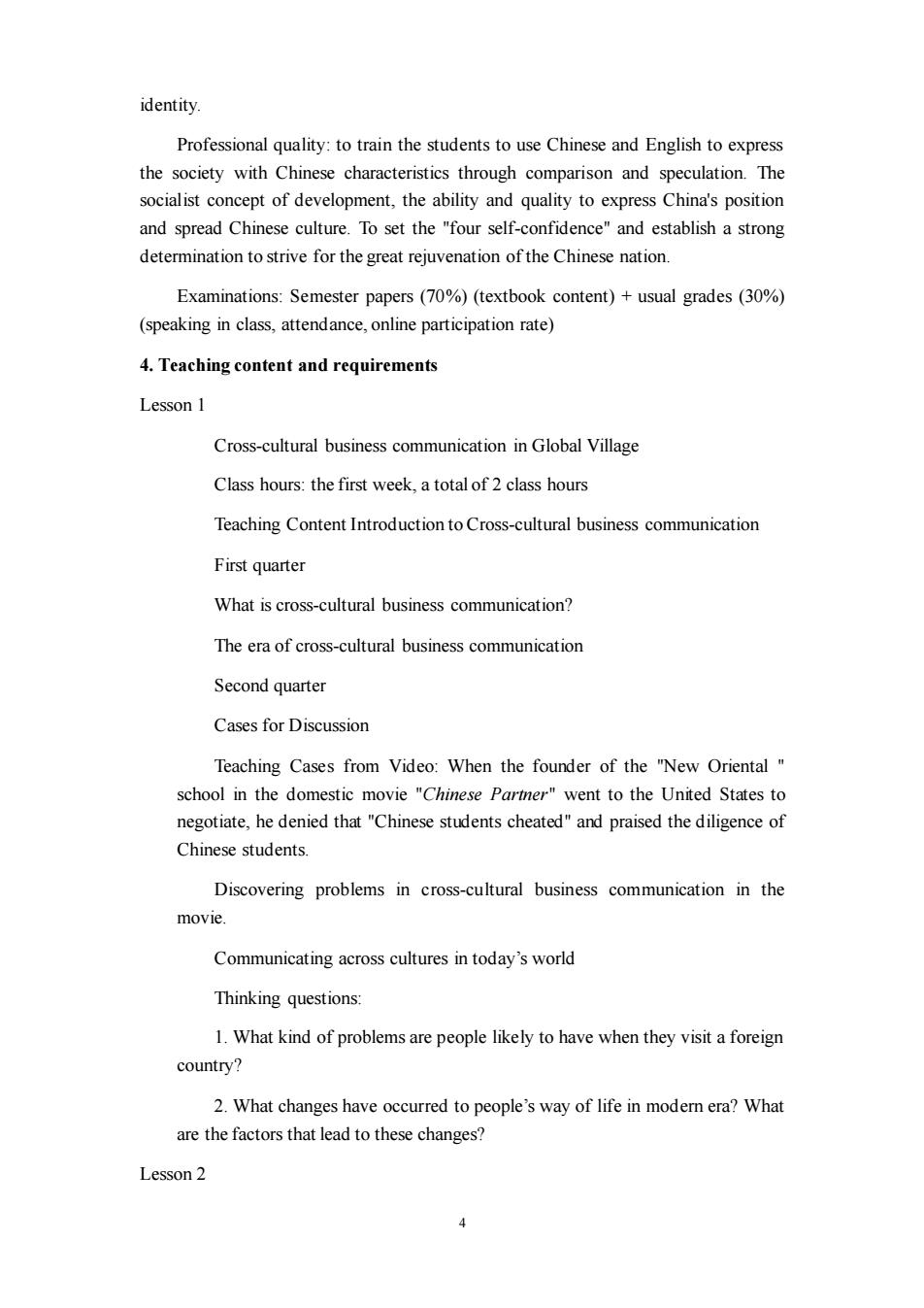
identity Professional quality:to train the students to use Chinese and English to express the society with Chinese characteristics through comparison and speculation.The socialist concept of development,the ability and quality to express China's position and spread Chinese culture.To set the "four self-confidence"and establish a strong determination to strive for the great rejuvenation of the Chinese nation. Examinations:Semester papers (70%)(textbook content)+usual grades (30%) (speaking in class.attendance.online participation rate) 4.Teaching content and requirements Lesson 1 Cross-cultural business communication in Global Village Class hours:the first week,a total of 2 class hours Teaching Content Introduction to Cross-cultural business communication First quarter What is cross-cultural business communication? The era of cross-cultural business communication Second quarter Cases for Discussion Teaching Cases from Video:When the founder of the "New Oriental school in the domestic movie"Chinese Parmer"went to the United States to negotiate,he denied that"Chinese students cheated"and praised the diligence of Chinese students Discovering problems in cross-cultural business communication in the movie. Communicating across cultures in today's world Thinking questions: 1.What kind of problems are people likely to have when they visit a foreign country? 2.What changes have occurred to people's way of life in modem era?What are the factors that lead to these changes? Lesson2
4 identity. Professional quality: to train the students to use Chinese and English to express the society with Chinese characteristics through comparison and speculation. The socialist concept of development, the ability and quality to express China's position and spread Chinese culture. To set the "four self-confidence" and establish a strong determination to strive for the great rejuvenation of the Chinese nation. Examinations: Semester papers (70%) (textbook content) + usual grades (30%) (speaking in class, attendance, online participation rate) 4. Teaching content and requirements Lesson 1 Cross-cultural business communication in Global Village Class hours: the first week, a total of 2 class hours Teaching Content Introduction to Cross-cultural business communication First quarter What is cross-cultural business communication? The era of cross-cultural business communication Second quarter Cases for Discussion Teaching Cases from Video: When the founder of the "New Oriental " school in the domestic movie "Chinese Partner" went to the United States to negotiate, he denied that "Chinese students cheated" and praised the diligence of Chinese students. Discovering problems in cross-cultural business communication in the movie. Communicating across cultures in today’s world Thinking questions: 1. What kind of problems are people likely to have when they visit a foreign country? 2. What changes have occurred to people’s way of life in modern era? What are the factors that lead to these changes? Lesson 2

Class hours:2 weeks,2 lessons in total Teaching content First quarter A wide-angle view of cross-cultural business communication Defining cross-cultural business communication Second quarter Cases for discussion Understanding aspects of cross-cultural business communication Cross-cultural business communication and its characteristics Thinking questions: Teaching Cases from Video:In the domestic movie "Gua Sha",the Americans misinterpreted the image of "Sun Wukong"in"Journey to the West" as a symbol of "violence" 1.Why does the author say a global village is technologically feasible now? 2.What are the essential ingredients of cross-cultural business communication?What kind of function does each serve in the communicative process? 3.What is the correct interational development of traditional Chinese images. Lesson 3 Class hours:3 weeks,2 lessons in total Teaching Content Introduction to Cross-cultural business communication First quarter Cross-cultural business communication and its characteristics Introduction to culture Second quarter Cases for discussion Culture and cross-cultural business communication:the skeleton link Teaching Cases of advertisement:Coca-Cola's brand marketing:Two Chinese dolls Ah Fu and Ah Jiao watching fireworks,receiving red envelopes. 5
5 Class hours: 2 weeks, 2 lessons in total Teaching content First quarter A wide-angle view of cross-cultural business communication Defining cross-cultural business communication Second quarter Cases for discussion Understanding aspects of cross-cultural business communication Cross-cultural business communication and its characteristics Thinking questions: Teaching Cases from Video: In the domestic movie "Gua Sha", the Americans misinterpreted the image of "Sun Wukong" in "Journey to the West" as a symbol of "violence". 1. Why does the author say a global village is technologically feasible now? 2. What are the essential ingredients of cross-cultural business communication? What kind of function does each serve in the communicative process? 3. What is the correct international development of traditional Chinese images. Lesson 3 Class hours: 3 weeks, 2 lessons in total Teaching Content Introduction to Cross-cultural business communication First quarter Cross-cultural business communication and its characteristics Introduction to culture Second quarter Cases for discussion Culture and cross-cultural business communication: the skeleton link Teaching Cases of advertisement: Coca-Cola's brand marketing: Two Chinese dolls Ah Fu and Ah Jiao watching fireworks, receiving red envelopes
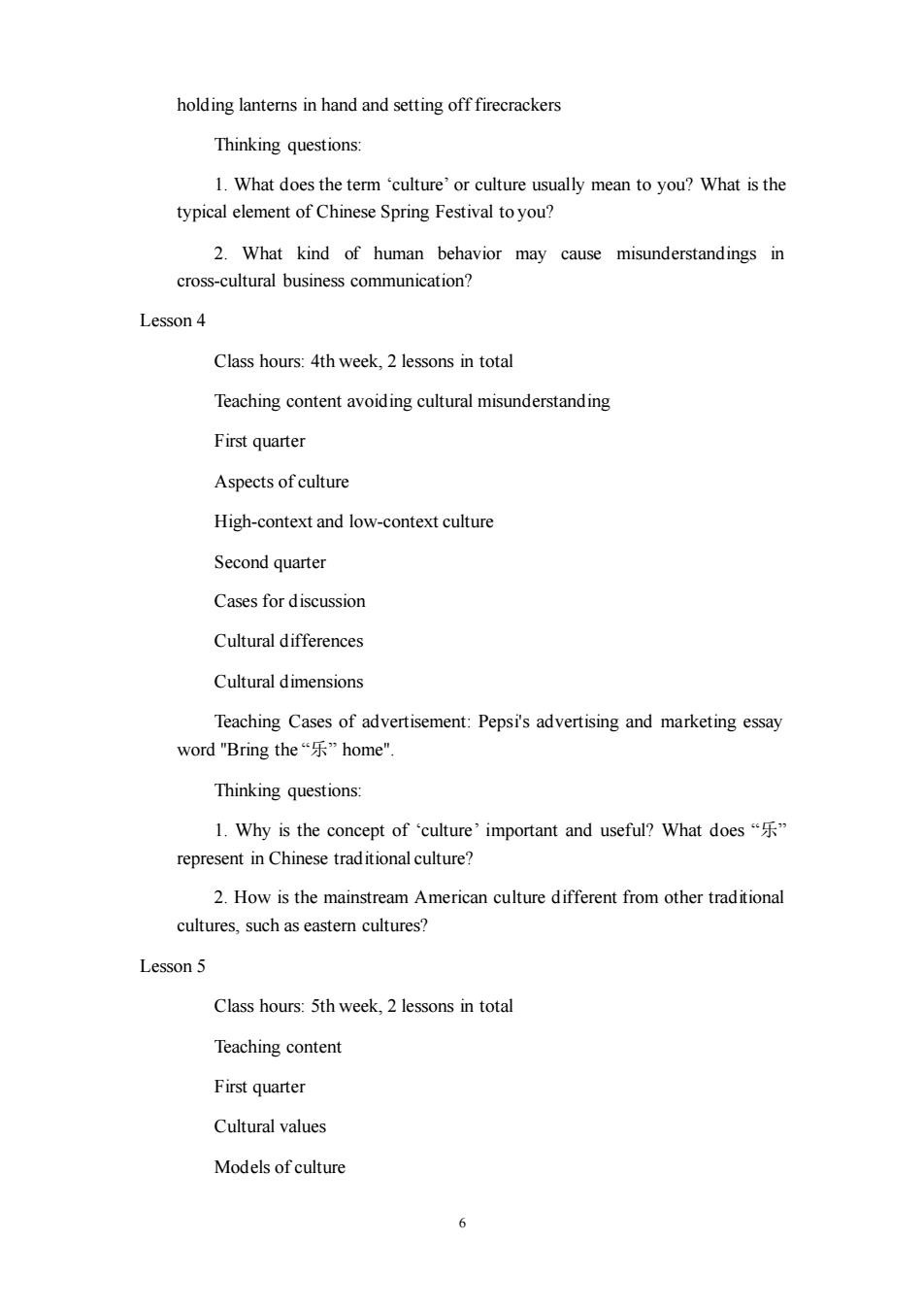
holding lantems in hand and setting off firecrackers Thinking questions: 1.What does the term'culture'or culture usually mean to you?What is the typical element of Chinese Spring Festival to you? 2.What kind of human behavior may cause misunderstandings in cross-cultural business communication? Lesson4 Class hours:4th week,2 lessons in tota Teaching content avoiding cultural misunderstanding First quarter Aspects of culture High-context and low-context culture Second quarter Cases for discussion Cultural differences Cultural dimensions Teaching Cases of advertisement:Pepsi's advertising and marketing essay word"Bring the“乐”home Thinking questions: 1.Why is the concept of 'culture'important and useful?What does" 2.How is the mainstream American culture different from other traditional cultures,such as eastem cultures? Lesson 5 Class hours:5th week,2 lessons in total Teaching content First quarter Cultural values Models of culture
6 holding lanterns in hand and setting off firecrackers Thinking questions: 1. What does the term ‘culture’ or culture usually mean to you? What is the typical element of Chinese Spring Festival to you? 2. What kind of human behavior may cause misunderstandings in cross-cultural business communication? Lesson 4 Class hours: 4th week, 2 lessons in total Teaching content avoiding cultural misunderstanding First quarter Aspects of culture High-context and low-context culture Second quarter Cases for discussion Cultural differences Cultural dimensions Teaching Cases of advertisement: Pepsi's advertising and marketing essay word "Bring the “乐” home". Thinking questions: 1. Why is the concept of ‘culture’ important and useful? What does “乐” represent in Chinese traditional culture? 2. How is the mainstream American culture different from other traditional cultures, such as eastern cultures? Lesson 5 Class hours: 5th week, 2 lessons in total Teaching content First quarter Cultural values Models of culture

Second quarter Cases for discussion Cultural appropriateness Teaching Cases of advertisement:Kai-Fu Lee's speech mentioned the story of the dismissal of the university "brother"who was mediocre and emphasis on those potential recruits and workers at Apple, Thinking questions: 1.What do you think is the appropriate way we should treat our foreign friends? 2.What differences are there between the Chinese understanding of friendship and the American one?What is the meaning of Justices? Lesson 6 Class hours:6th week,2 lessons in total Teaching content Introduction to the American culture First quarter The basic unit of society:the individual unit or the collective? The relationship between culture and language Second quarter Cases for discussion Language and its cultural influence Teaching Cases of advertisement:Teaching Cases from Video:When the founder of the "New Oriental"school in the domestic movie "Chinese Partner went to the United States to negotiate,he denied that"Chinese students cheated" and praised the diligence of Chinese students. Thinking questions 1.Do cultural distance and geographical distance coincide? 2.Does contact between different cultures necessarily increase intercultural understanding? 3.How the negotiations in the movie reflects that Chinese attach importance to the sense of collective honor? >
7 Second quarter Cases for discussion Cultural appropriateness Teaching Cases of advertisement: Kai-Fu Lee's speech mentioned the story of the dismissal of the university "brother" who was mediocre and emphasis on those potential recruits and workers at Apple, Thinking questions: 1. What do you think is the appropriate way we should treat our foreign friends? 2. What differences are there between the Chinese understanding of friendship and the American one? What is the meaning of Justices? Lesson 6 Class hours: 6th week, 2 lessons in total Teaching content Introduction to the American culture First quarter The basic unit of society: the individual unit or the collective? The relationship between culture and language Second quarter Cases for discussion Language and its cultural influence Teaching Cases of advertisement: Teaching Cases from Video: When the founder of the "New Oriental " school in the domestic movie "Chinese Partner" went to the United States to negotiate, he denied that "Chinese students cheated" and praised the diligence of Chinese students. Thinking questions: 1. Do cultural distance and geographical distance coincide? 2. Does contact between different cultures necessarily increase intercultural understanding? 3. How the negotiations in the movie reflects that Chinese attach importance to the sense of collective honor?
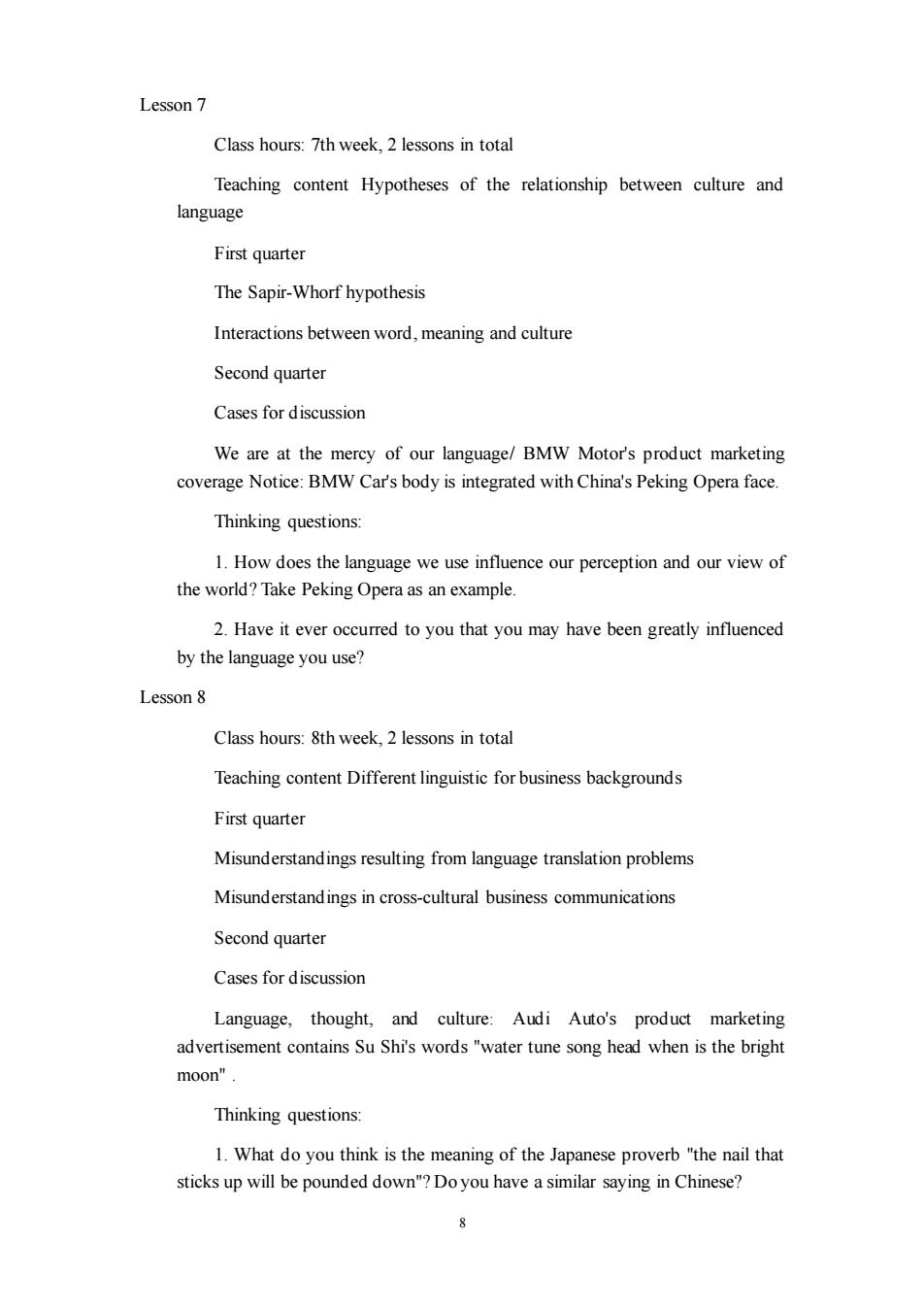
Lesson 7 Class hours:7th week,2 lessons in total Teaching content Hypotheses of the relationship between culture and language First quarter The Sapir-Whorf hypothesis Interactions between word,meaning and culture Second quarter Cases for discussion We are at the mercy of our language/BMW Motor's product marketing coverage Notice:BMW Car's body is integrated with China's Peking Opera face. Thinking questions: 1.How does the language we use influence our perception and our view of the world?Take Peking Opera as an example. 2.Have it ever occurred to you that you may have been greatly influenced by the language you use? Lesson8 Class hours:8th week,2 lessons in total Teaching content Different linguistic for business backgrounds First quarter Misunderstandings resulting from language translation problems Misunderstandings in cross-cultural business communications Second quarte Cases for discussion Language,thought,and culture:Audi Auto's product marketing advertisement contains Su Shi's words"water tune song head when is the bright moon" Thinking questions 1.What do you think is the meaning of the Japanese proverb "the nail that sticks up will be pounded down"?Doyou have a similar saying in Chinese?
8 Lesson 7 Class hours: 7th week, 2 lessons in total Teaching content Hypotheses of the relationship between culture and language First quarter The Sapir-Whorf hypothesis Interactions between word, meaning and culture Second quarter Cases for discussion We are at the mercy of our language/ BMW Motor's product marketing coverage Notice: BMW Car's body is integrated with China's Peking Opera face. Thinking questions: 1. How does the language we use influence our perception and our view of the world? Take Peking Opera as an example. 2. Have it ever occurred to you that you may have been greatly influenced by the language you use? Lesson 8 Class hours: 8th week, 2 lessons in total Teaching content Different linguistic for business backgrounds First quarter Misunderstandings resulting from language translation problems Misunderstandings in cross-cultural business communications Second quarter Cases for discussion Language, thought, and culture: Audi Auto's product marketing advertisement contains Su Shi's words "water tune song head when is the bright moon" . Thinking questions: 1. What do you think is the meaning of the Japanese proverb "the nail that sticks up will be pounded down"? Do you have a similar saying in Chinese?
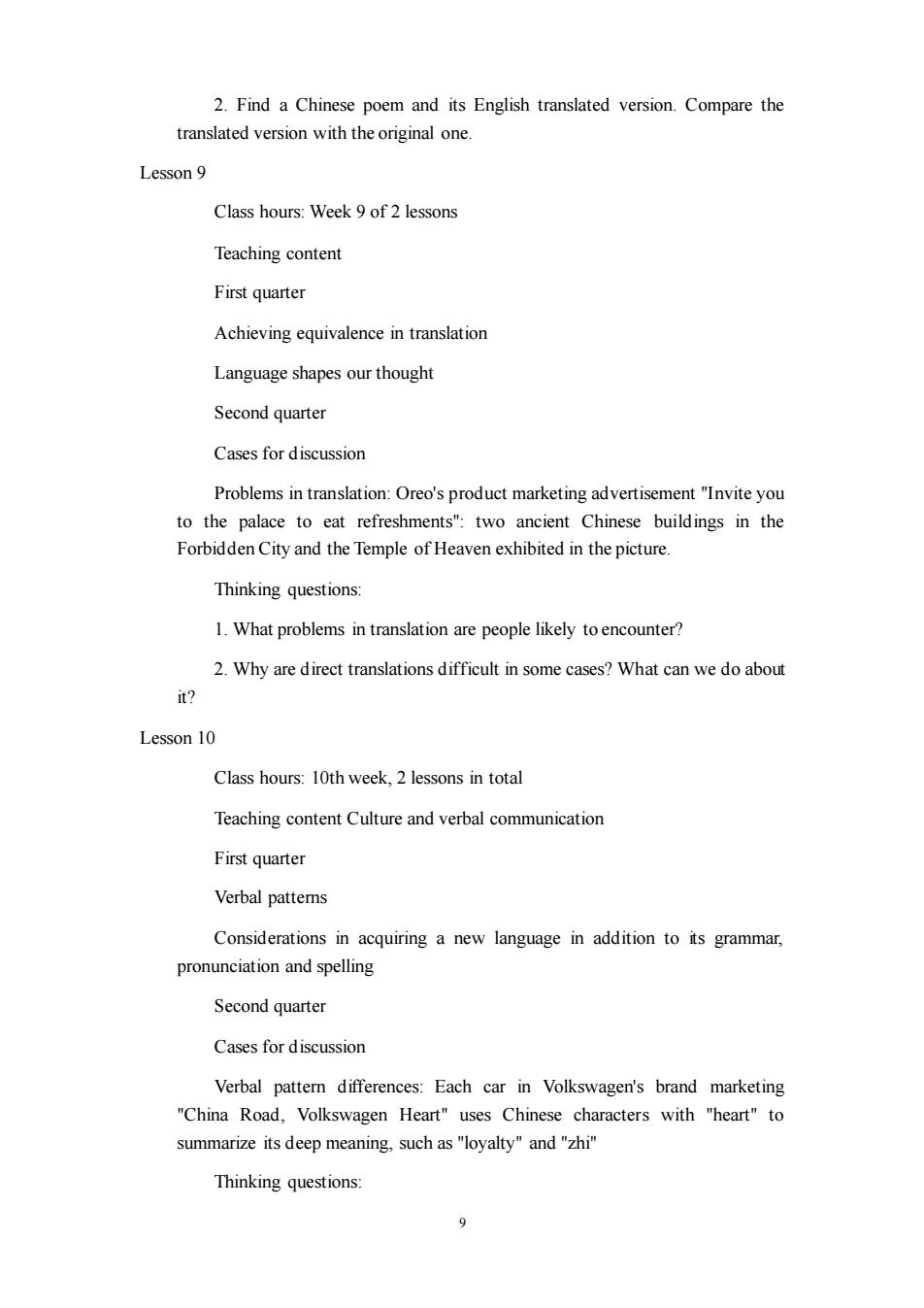
2.Find a Chinese poem and its English translated version.Compare the translated version with the original one. Lesson 9 Class hours:Week 9 of 2 lessons Teaching content First quarter Achieving equivalence in translation Language shapes our though Second quarter Cases for discussion Problems in translation:Oreo's product marketing advertisement"nvite you to the palace to eat refreshments":two ancient Chinese buildings in the Forbidden City and the Temple of Heaven exhibited in the picture. Thinking questions: 1.What problems in translation are people likely toencounter? 2.Why are direct translations difficult in some cases?What can we do about it? Lesson 10 Class hours:10th week,2 lessons in total Teaching content Culture and verbal communication First quarter Verbal pattems Considerations in acquiring a new language in addition to its grammar. pronunciation and spelling Second quarter Cases for discussion Verbal pattern differences:Each car in Volkswagen's brand marketing "China Road,Volkswagen Heart"uses Chinese characters with "heart"to summarize its deep meaning.such as"loyalty"and"zhi" Thinking questions: 9
9 2. Find a Chinese poem and its English translated version. Compare the translated version with the original one. Lesson 9 Class hours: Week 9 of 2 lessons Teaching content First quarter Achieving equivalence in translation Language shapes our thought Second quarter Cases for discussion Problems in translation: Oreo's product marketing advertisement "Invite you to the palace to eat refreshments": two ancient Chinese buildings in the Forbidden City and the Temple of Heaven exhibited in the picture. Thinking questions: 1. What problems in translation are people likely to encounter? 2. Why are direct translations difficult in some cases? What can we do about it? Lesson 10 Class hours: 10th week, 2 lessons in total Teaching content Culture and verbal communication First quarter Verbal patterns Considerations in acquiring a new language in addition to its grammar, pronunciation and spelling Second quarter Cases for discussion Verbal pattern differences: Each car in Volkswagen's brand marketing "China Road, Volkswagen Heart" uses Chinese characters with "heart" to summarize its deep meaning, such as "loyalty" and "zhi" Thinking questions: